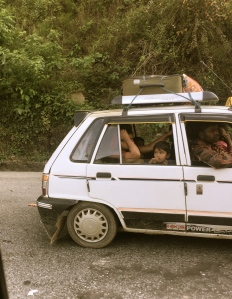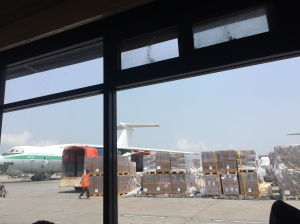
The quake was just the beginning of Nepal’s tragedy. Two days after the opening of the highway out of Katmandu, thousands of people flooded out of the city. The thought was simple, as the earthquake continues with it’s after shocks, especially on the 26th (Sunday) where the shock was as big as 6.5 magnitude, fear re-settled in many. Many locals believe it was the nature trying to shake people out of the busy city of Katmandu while workers and investors fear the consequences of this curse by nature.
Immediate Consequences
“The first few days at the hospital was dreadful, one hospital rejected to treat me as my problem was insignificant compared to others and other hospitals were busy moving people out of the building, fearing the collapse“ expressed one of the victims who broke his feet during the earthquake. Although he knew that he would need a surgery and should be acting immediately to prevent blood from clotting in his leg, all he could do was to wait for his scheduled flight and undertake the surgery abroad. Unfortunately, not everyone could afford this kind of treatment.
The fear for bigger earthquakes is the main reason for people leaving the city expressed factory owners who have lost in touch with all his migrant workers who have worked for him for the past five years. Needless to say, it will be a tough ride for small enterprise owners like these who will either have to immediately employ new workers or just wait for the old workers to return eventually.
Everything is Katmandu is in a halt. Schools are closed and many shops are not in the state to re-open. Yet, the most affected are the daily wage earners who rely on their daily wage for rice and curry. With the rising costs for these staple foods, it is the vulnerable that are suffering the most.
The long-term consequences are even bigger for the country. Nepal’s tourism sector has just started booming. In 2012, the country attracted nearly 600,000 foreign tourists, a 10% cent increase on the previous year[i]. From walking towards being the Switzerland of the East, Nepal will now be known for it’s earthquake and dangerous trekking routes. Definitely a nightmare for Nepal’s tourism sector which employs 7.0% of total employment (1,112,000 jobs).
International Aid and Help
It is overwhelming to see the amount of aid rushing in the country as soon as the earthquake struck Nepal. Neighboring India was the first to provide the victims with relief materials and help Indian citizens move out of the country.
Yet, even citizens from economically unstable nations like Myanmar are contributing to help the people of Nepal. It is extraordinary. But the thing to consider is mainly the effectiveness of all these contributions. Are the victims really given what they need?
Ms. Puja Poudel, who is part of a student team which provided aid to victims in remote areas four days after the earthquake expressed her concerns; “As the media emphasized on the effects of the earthquake on Katmandu and a few villages around it, some villages that are less known to people have not received anything.” The students focused on improving the sanitation for people who have lost their homes to prevent any possible water and waste borne diseases. It is sad and difficult to comprehend why aid has still not been delivered to the victims five days after the earthquake. The money is there but the system and capacity is lacking. As the rainy season is about to set in, the villagers are longing for some hopeful words from the government.
Tips and Suggestions
It is remarkable to see how affectionate the people in the world are. Many are helping aid organizations in their respective countries by raising funds and some even rushing to Nepal themselves to volunteer/ provide relief materials.
This is overwhelming but I would like to share some experience to encourage research and effective giving.
On my way to Myanmar from Katmandu, my flight was delayed since there was no space in the runway. Yes, that was 5 days after the earthquake. Relief materials sent from around the world was still stranded in the airport and some food had to be even thrown away because no one in the government was available to deliver them! This is clearly shameful because a government can do anything. If the government needs volunteers, the youth in the country would run to assist the government who is helping its people but now, the youth are knocking the doors of neighbors for money during such difficult to help victims while the relief materials stay stranded in the airport.

Local TV news channel has also captured images of civil servants snatching away some of the tents sent from various countries to the quake victims. Things are being sold in the black market and people are taking advantage of the vulnerable in such a critical time.
Hence, don’t forget to check how the what the charity you are giving to are doing. Are they sending relief via the government or through the locals? Which areas are the covering etc. Of course, everyone is too busy to do this but maybe spending 5 minutes of your time on a mini research, your money may actually go to someone in real need.
A lot of support will be required after the disaster for the economy to recover. It might be proven a better idea to contribute once the media stops talking about the issue. This will be a crucial time for the country where donations and contributions will fall while the need for reconstruction remain.
It’s amazing how the world is full of compassionate people and definitely a shame to know that a few countries are still governed by selfish and corrupt governments.
